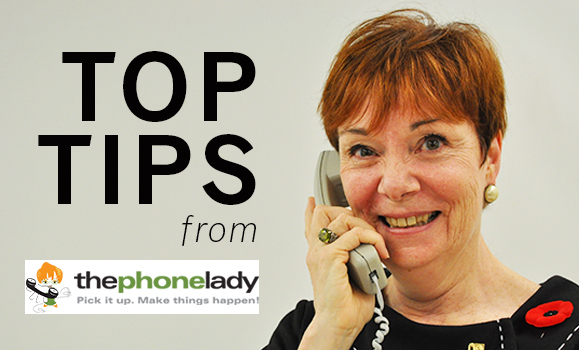News
» Go to news mainTop tips from the Phone Lady

In a world of overwhelming communications, we're all looking for ways to filter through the information you don’t need to find the key pieces you do. Mary Jane Copps (aka The Phone Lady) has been analyzing the psychology of the phone call for over 27 years and has some great advice to help us practise efficient ways of communicating.
She encourages us all to be “Communications Heroes”. In other words, lead by example by having engaging phone calls and creating clear, concise emails. Here’s how:
The medium is the message
Phone vs Email
Save time and energy by chosing the right medium, which will depend on what you are trying to achieve.
The phone is the best medium to use for emotional engagement and relationship building. A phone conversation allows you to express your emotional response through the intonation in your voice and to add extra details to the conversation. Email can often be misinterpreted because tone and context is more difficult to convey.
Using the phone is good when you need an immediate decision, or when you need clarification or follow-up on an email. Teleconference calls are good when you need a group decision.
Email is best used to share detailed information, to reach lots of people quickly and to keep everyone in the loop. It also is a good way to keep a paper trail and it allows us to chose words and thoughts carefully.
Tips when using the phone…
Don’t answer your phone on the first ring
The phone has interrupted you but you don’t want to “throw” the sound of being interrupted as this will make your caller feel they are inconveniencing you. Stop what you are doing, and smile–even though the caller can’t see you. This sounds a little strange, but a smile will change the shape of your mouth and the sound of your voice will be friendlier.
Eliminate phone tag
When leaving a voicemail, increase your reach by providing information on when you’re available and let them know if you will follow up with them again. This shows you respect their time. You can also create curiosity to motivate them to call you back: “I have a couple of quick questions…”
Redirect the conversation from a "constant talker”
If you have a colleague who often traps you on the phone line with stories of their vacation to Punta Cana, get their immediate attention by saying their name. This gives you a window of opportunity to steer the conversation back to why you called in the first place.
End the call by making it about them: “I don’t want to take up any of your time, I’ll speak to you again soon. Thanks so much for your help.”
Be your own receptionist
Multitasking breaks focus. For every interruption, it takes approximately 12 minutes to refocus on what you were previously doing. Multiply that by 5, that’s a whole hour of productivity lost!
Utilize your voicemail message by indicating your availability: “I will be answering phone calls between 1 and 3pm, if you need to contact me urgently, please reach me by email…”
Provide yourself with the necessary time to focus on tasks and ultimately, be more productive.
Schedule phone calls and create an agenda
Treat a phone call as a mini meeting. Use a calendar invite to schedule a phone call and have a list of points you want to discuss in the notes field so everyone can stay on track.
Don’t take it personally
The world of communications has changed, everyone is overwhelmed and so returning a phone call is no longer considered poor etiquette. Don’t judge people or take it to heart, there could be one of many reasons why they haven’t called you back.
Tips when using email…
Keep emails concise
Don’t overwhelm people with long scrolling emails that makes your reader break out into a cold sweat. In our fast-paced world, we tend to scan emails looking for key information or action items.
Make life easier by using formatting and sometimes images to make your emails more digestible. Use headings or different colours to break up chunks of text and numbered lists or bullets to indicate key points and action items. Use bold or underline to emphasize key information.
Subject line should contain vital information
Use project names or meetings in the subject line to allow everyone to find and file information more efficiently when scanning or searching their inbox.
If you have an urgent request, place it in the subject line: “PLEASE REPLY” or “URGENT REQUEST” –Don’t bury it in the body of the email where it could easily get missed.
Don’t forget to change the subject line if it no longer applies to the conversation thread. This will help you search emails more efficiently and save time when searching for content.
Take yourself (and others) out of the loop
If your entire department has been CC’d on an email and you don’t want to keep receiving the thread of messages, let them know. Reply once, take yourself out of the email conversation by letting your peers know: “Thank you for including me, I don’t need to be included on future emails for this project”.
Likewise, don’t add unnecessary emails to colleague’s inboxes. Before hitting send, check to see who doesn’t need to see your email.
Be cautious when using emotion, humour or sarcasm in emails
If you don’t know someone well enough, leave out the email jokes. They can often be misinterpreted, leaving you with a red face and a damaged relationship.
Recent News
- Explore TED Talks Series
- Employee Benefits update
- Employee Benefits Newsletter – Renewal Issue
- April 9: Update on Economic Adjustment
- Call for nominations for 2019 DPMG Committees
- Know your neighbour: Stephanie Rutherford
- Know your neighbour: Erin Stewart‑Reid
- Know your neighbour: Matthew Guy

